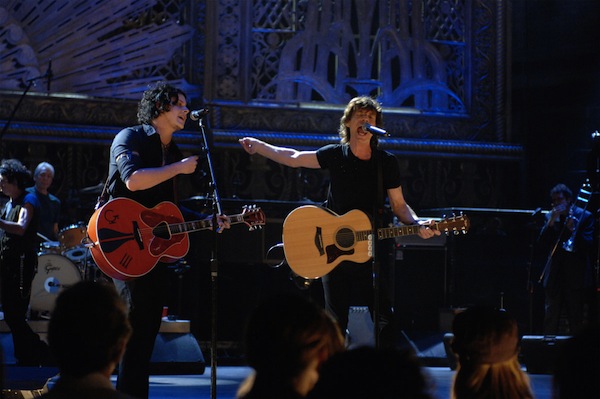Movie review by Greg Carlson
Paid attendance for another Rolling Stones concert film assumes a kinship with the subject matter, and fans new and old alike are offered plenty of sights and sounds to quicken the pulse during the course of Martin Scorsese’s spry crack at one of rock’s unstoppable acts. It may or may not be the same as winning an Oscar, but Scorsese joins an elite rank of filmmakers who have attempted to capture some essence of the Stones. Over the years, Jean-Luc Godard, Hal Ashby, Robert Frank, and Albert & David Maysles directed the band to varying degrees of success, and Scorsese’s encomium serves as an excellent companion piece to several of the earlier works.
Assisted by a jaw-dropping army of some of the finest cinematographers in the game, including Robert Richardson (the credited lead D.P.), Robert Elswit, Ellen Kuras, Andrew Lesnie, John Toll and Emmanuel Lubezki – to name a handful – Scorsese puts the viewer right on the stage of NYC’s Beacon Theatre. The movie’s tongue-in-cheek prologue sees the increasingly wizened Scorsese acting the part of the befuddled maestro, wringing laughs from his inability to track down a set list. After a speakerphone conference with Mick Jagger, a mock-exasperated Scorsese whimpers that it would be nice to be allowed a camera that moves. It’s all something of a put-on, working as a kind of tease before the band takes the stage.
“Shine a Light” is not “The Last Waltz,” but then, not as much is at stake. The Rolling Stones have defied the odds as the years have yielded to the decades, and like Bob Dylan, the subject of Scorsese’s superior “No Direction Home,” the group deserves some credit for its unprecedented longevity. Yes, they are obliged to perform “Jumpin’ Jack Flash,” “(I Can’t Get No) Satisfaction” and “Start Me Up,” because the largest numbers of fans love to hear them. The deeper cuts are more satisfying, however, and “Shine a Light” slips in several outstanding arrangements, including a terrific (albeit slightly sanitized) “Some Girls,” a delightful “Far Away Eyes,” and a sweet Keith Richards/Ron Wood duet on the former’s signature “You Got the Silver.”
The unlikely trio of special guests – Jack White, Christina Aguilera, and Buddy Guy – are allotted one number each. In what might be the movie’s highlight, White and Jagger trade lines on a tremendous rendition of “Loving Cup,” often sharing the microphone for the song’s ebullient refrain. Jagger was 37 years old when Aguilera was born, but he still feigns well-practiced libidinousness on a decent run at “Live with Me.” Buddy Guy, age 70 at the time of filming, has a few years of seniority on the Stones, and they treat him with appropriate reverence. His switchblade-sharp work on Muddy Waters’ “Champagne & Reefer” hurts so good, an awestruck Keith gives his guitar to Guy at the song’s conclusion.
Periodically, Scorsese intercuts career-spanning interview footage of the band. It mostly serves to reinforce the inspiring journey of four decades of hard work as the fellows now write their autumnal chapter. The images are also striking for containing evidence of Jagger’s patience and politeness. In clips dating to the 1960s, he courteously answers a battery of inane questions, exposing their ridiculousness with his earnest-sounding responses. Surely, he would rather be on stage, and for the most part, “Shine a Light” is happy to oblige.
